George Mason
Inductee Hall of Fame 2022
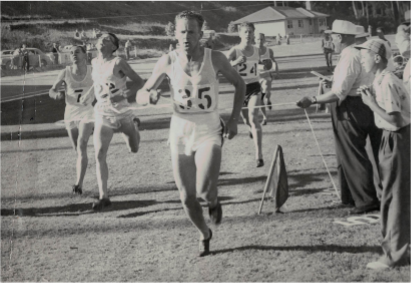
For the first time, we have a Greyhound Hall of Fame inductee, that is already in another Hall of Fame. George Mason was highly influential in all aspects of greyhound racing on the Northwest Coast, and indeed statewide, from owning, training and breeding on a modest but persistent scale, to huge Devonport Club representation at every level, and a prolonged and distinguished period in the administration of our sport on the Tasmanian Greyhound Racing Board.
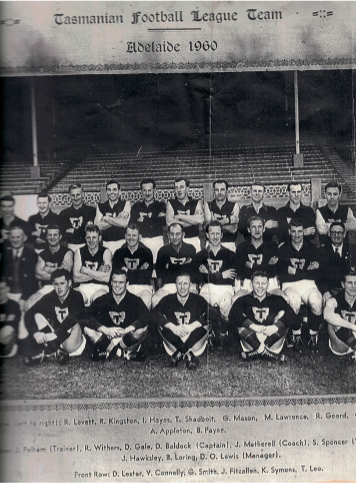
George Mason was born in Sheffield on 27 May 1935 to “Chum” and Elsie Mason (nee French). He was the second born of seven children, and his marvellous sporting prowess dominated his life at least till his late twenties. An outstanding runner, George won many of the major quarter mile and mile Gifts such as Burnie and Roseberry on the Northwest and West Coast. He also ran one time at the Easter Stawell carnival, the biggest weekend in Australian athletics. He was coached by legendary men such as Reg Cullen and Reg James, and in 1990 the Burnie Athletic Club issued George with a Golden Pass to all subsequent New Year carnivals at Burnie.
Even more legendary was George’s Australian Rules Football deeds. A six-foot two-inch-high marking ruckman come defender, with abundant speed, he was highly sought by most of the Coastal teams at various times, amid his exploits at Cooee and Latrobe in particular. He was part of the NWFU team that defeated the TFL in 1959, and a year earlier, he was chosen to play for one of the finest Tasmanian teams ever assembled. At just 23, he played alongside football legends such as Darryl Baldock (Captain), Don Gale, Bob Withers, Rex Geard and Trevor Leo in the National Carnival in Melbourne. He again represented his State with the great John Leedham as captain in 1960. At a Gala Dinner in Hobart on 15 July 2005, George Mason, along with many of those legendary names, was inducted into the Tasmanian Football Hall of Fame.

George Mason married Dorothy Shephard on 23 January 1960 and they had three children in Gaye, Leon and Nigel, plus eight grandchildren and one great-grandchild. In 1955 George had a brief stint of National Service with the North-West Volunteer Military Force. Known somewhat as a jack of all trades, George had qualified in carpentry in 1951, and later in joinery also. These skills led him to teach, initially at Natone before stints at Burnie High and Parklands High. When he was transferred south to Glenora, George decided after one inspection, that was as not to be and resigned. After spending a period working in building and repairs for Dorothy’s father George Shepherd, George was offered another teaching role at Reece High School (allied to playing football for Devonport). After fifteen years at Reece, George moved to Ulverstone High School, his final posting before “retiring” at age fifty-five. Making good use of his trade skills, George became a fix-it man of all sorts and stated that he never worked harder in his life.
Amid this family, sporting and workplace mayhem, George was ever besotted with all things greyhound. Both George and his brothers Peter and Des developed a deep interest in the sport at an early age, primarily through their adopted brother Reg Carpenter’s strong interest. Reg was to train the champion bitch Nippy Cola for Des in the early 1960’s.
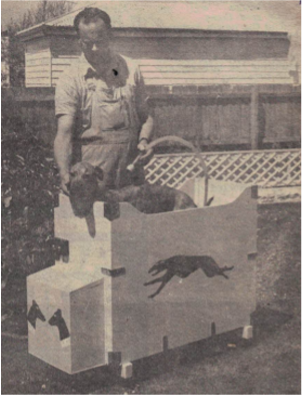
A little-known fact is the Devonport Greyhound Racing Club was actually formed on 17 March 1939, with Walter Bond the founding Secretary. It wasn’t until post-World War Two 1945 that he was able to apply for a lease at the Showgrounds site. Finally work on building the track and associated utilities was in full swing by 1951, with all the big Coastal names like Reg Ivory playing major roles. The seventeen-year-old handyman George, also participated strongly, especially with maintenance work, in the many working bees to get things up to speed. In the Devonport Club’s 3 March 1976 Race Program, the Editorial quoted George as “the man who did more than anyone to install the mechanical hare at the track”. The dedication and hard work of all, came to fruition when the first race meeting was staged on Thursday night 3 April 1952. Just a month shy of his eighteenth birthday, George Mason had a competitor in the very first race, the J.H.Astill Stakes, won by Fred Hollett’s Franklin Boy. George’s bitch Just Darling finished 9th of 10 over the 465 yards … but he was off and running in the sport he grew to love!
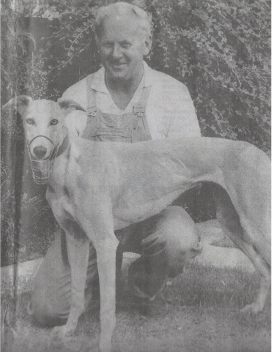
The great attachment of owning and training dogs was a continual part of George’s life from Just Darling right through the next four decades into the late 1980’s. Always with small numbers, George loved the challenge of turning dogs around that others had given up on. Nevertheless, some outstanding chasers cropped up as well. The best was Trycola, a March 1963 fawn bitch by Tryola from the champion Des Mason owned Nippy Cola. A prolific winner on all tracks, Trycola was a Maiden Thousand Heat winner, won three in a row over 685 yards at the T.C.A. including a Final, and was a Heat winner and 2nd in a 580-yard Spreyton Stakes Final at Devonport. The Mercury wrote that “she sticks like a debt collector”. Her crowning glory, however, was making the Final of Fairburn Lady’s 1965 Hobart Thousand, when a mere 24 months old. After her Heat victory and Semi Final 2nd, she finished 7th in Tasmania’s biggest race.
Royal Feeling, the regally bred blue brindle son of Tivoli Chief – Clunworth, was George’s best dog in the 1970’s. Trained for L. and I. McNab, Royal Feeling won five of his first eight starts with George, including the Holiday Stakes Heat and Final at White City. Royal Feeling was also part of George’s highlight training performance, when, in 1977 he was the equal fastest Heat winner of the Devonport Cup. George also won a Heat that night with Purple Design and made it a treble with the extra smart Forked Tongue.
During the eighties, George Mason prided himself in winning with Golden Tracey, which had twice been outed by the Stewards. One wag had told George “ that bitch will never get distemper cos’ she’ll fight it off”. At career end, Golden Tracey produced a litter to Ballarat Prince, which produced the useful Ablazer trained by brother Des Mason and George’s best bitch of that period, Uclaptu. This blue fawn hit the ground running with a Heat and Semi victory in the 1985 Maiden Thousand, before finishing 5th to Summer Reign in the Final. A month later, Uclaptu won the Heat and Final of the Coca-Cola Bottlers Juvenile at the Royal Showgrounds in Hobart, capturing the $1200 booty. Three starts later she made it five on the trot in a Breeders Classic Heat at Devonport. In July 1986 she won her heat of the Tasmanian Oaks at White City, before winding up 3rd to Touch Of Luck in the prestigious Final.
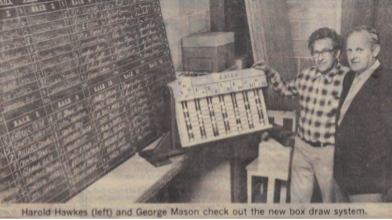
George Mason, ever clever with his handyman skills, also made an elite-style greyhound trailer during the 1970s (the Devonport Club guide suggested it was more like a dog caravan). He also made his own hydro bath which he used on his charges for a considerable period.
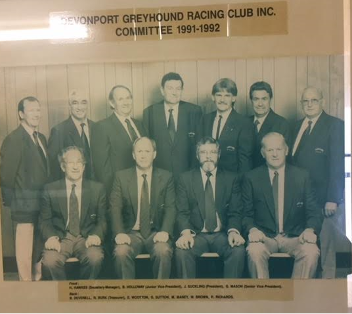
George Mason’s overwhelming contribution to Tasmanian greyhound racing, and in particular, the Devonport Greyhound Racing Club, was his Committee work through the 1970s, 80’s and early ’90s, and his significant role on the Tasmanian Greyhound Racing Board for most of the 1980s. George was a strong character. He was both confident and bullish, even intimidating at times. He could be the life of a party but took his administrative roles extremely seriously. And he was hard but extremely fair in decision-making. He would roll up his sleeves in assisting with anything maintenance based and had a very strong repour with young and old.
George was already embedded on the D.G.R.C. Committee by the early 1970s under President Dr Leslie Sender. By 1976 George was already a D.G.R.C Life Member and after a period as Vice President, took over as Club President. He was to hold that position right through until the late 1980s. When Jim Suckling took the reins in 1990, George remained as Vice President for a time. This was a strong period of growth for greyhound racing in Devonport, with a strong Committee of dedicated greyhound folks such as George, Jim Suckling, Gary Sutton, Brian Holloway, Butch Deverell, Rex Richards, Mike Maney and several others. It was greyhounds run by greyhound people … sadly missing today! Under George Mason’s Presidency, many innovations and improvements took place … never just a “George thing”, but a Club working towards a unified cause. It saw Harold Hawkes appointed Secretary – Manager during the 79-80 Season, a great inclusion because of

his strong association with their tenant, the Devonport Agricultural and Pastoral Society. A huge step forward was made with the improved track lighting at this time, following many years of less than favourable conditions. Upgraded reconditioning and maintenance of the lure also enhanced racing, with no races lost in the 79-80 season in particular. The Club paid out a record $68,037 in prizemoney in the 1979-80 season and one charity meeting raised in excess of $1200.
It was a period of great stability, with Gary Sutton the long-time race caller, and member of this stable committee, a strong and dedicated Women’s Committee, and many reliable and generous sponsors and trophy donors like Brambles, Tom McKenna, the Northwest Greyhound Owners Trainers and Breeders Association, as well as many other individuals. Each Club was still responsible for its own grading and box draws at this time, some of which was clumsily done. Handyman George came up with an innovative box draw invention of his own, which he built along a tattslotto style draw. This made draws easier to conduct and provided far greater transparency.
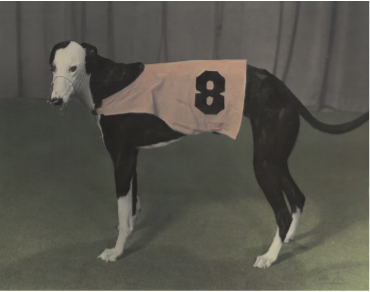
Around 1982, the Tasmanian Government centralized most aspects of greyhound administration and integrity, in establishing the inaugural Tasmanian Greyhound Racing Board, situated in Launceston. It appointed Clem Hoggett as Chairman and each Club nominated its preferred representative. George Mason was the logical choice for both the Government and the Devonport Club. His knowledge and involvement in all things greyhound on the northwest coast were second to none, plus he’d already been the marking and ear brand official for the National Coursing Club in that region for more than a decade. His appointment to this Board, which helped shape the future of our sport, was deemed successful enough, that State Racing Minister Ian Braid offered George a second term in 1987, which he accepted.
George Mason always maintained his interest in greyhounds, and brother Peter would still put his T.A.B. dabbles on, right up to his death on 14 June 2016, in his 82nd year. Very few greyhound folks have had as a great an influence, and across so many spheres on our sport, as George Mason. He was a “Rock of Gibraltar” to many in greyhound racing, especially with his beloved Devonport Greyhound Racing Club. So very deservedly, he now enters the Tasmanian greyhound Hall of Fame.
By Greg Fahey
